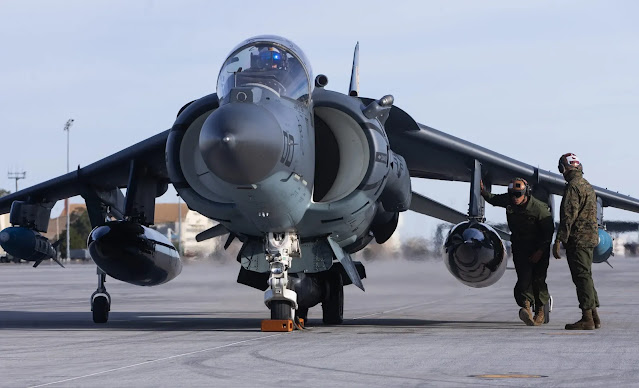
|
| AV-8B Harriers were the best VTOL military planes |
>AV-8B When they were first used by the military in the 1980s, Harriers were the most advanced VTOL planes.
Ever since the first helicopters took to the air, the concept of a vertical takeoff and landing aircraft has been kicking around. Yes, a helicopter can do that, but we're talking about a full-fledged aircraft, like a fighter jet, that can take off vertically and hover like a helicopter, as well as conventionally and from a short runway. It shouldn't be a surprise that the military has made a lot of VTOL planes, but the vast majority of them were just prototypes that were never used. Such as the Russian Yak-38 Forger, which was made for the Kiev class of aircraft carriers and can take off and land vertically. But even though it was used by the Soviet Navy, the plane had a number of major problems.
The Development of the Harrier
The Hawker Siddeley P.1127, later known as the Kestrel, was the first version of the Harrier to take to the skies in November 1960. The P.1127 served as the blueprint for the Harrier, and it looked strikingly similar to the final product. The plane's single Bristol Siddeley Pegasus 5 vectored-thrust turbofan engine made it possible for it to take off and land vertically, or in much less space than a regular jet plane. The name of the engine on the plane itself gives it away.
Four nozzles, two on each side of the aircraft, were used to direct the thrust from the engine due to the vectored-thrust nature of the engine. The plane could do vertical takeoffs and landings if the nozzles were pointed straight down. Simply turn them around, and you can adjust the plane for a shorter takeoff run, or a more standard one if you're using a standard runway. Taking off on the autobahn in Germany or in the middle of a remote forest during a battle would be perfect scenarios for the shorter or vertical takeoffs.
_Air_Combat_Element_(ACE).jpg)
|
| Harriers are a vital part of any military operation and have helped win many wars |
They are extremely versatile and able to perform a variety of tasks, including ground attack, reconnaissance, and air superiority
In 1969, the first Harriers were put into service with the RAF and the Royal Navy; they would also be used by other air forces, including the United States Air Force. Several versions of the plane would be made, such as the second-generation Harrier GR.5, GR.7, GR.9, and the Navy-only Sea Harrier. Because it was known at first to be hard to fly, the Harrier needed pilots with a lot of experience. When the RAF sent a large number of them to West Germany, though, they quickly demonstrated their adaptability.
In 1975, when Guatemala was in the middle of a civil war and the British garrison in Belize needed protection from an impending invasion, the plane was sent there because it could change to fit the situation. The Harriers saw active service throughout their lifespans. One of the most well-known times British Harriers were used in combat was when the later-model British Aerospace Harrier II versions were sent to Afghanistan. But perhaps its most well-known appearance and battle service was in 1982, during the Falklands War, when it served as both an RAF and a Sea Harrier.
Harriers are a vital part of any military operation and have helped win many wars
The Falkland Islands were sent RAF Harrier GR.3s and Sea Harriers from HMS Invincible and HMS Hermes to protect them from an Argentine attack. There were a total of 28 Sea Harriers and 14 GR.3s used, but the Argentines used a much larger fleet. The Harriers faced off against A-4 Skyhawk attack planes, Mirage III fighters, and Dagger fighters. Two Harriers were lost to ground fire and four more were lost in accidents, but not a single Harrier was shot down by an Argentinian aircraft. In air-to-air combat with the Harrier, some 20 Argentinian aircraft were shot down because they were no match for the British aircraft's agility.
With the release of the Strategic Defense Review in 2010, the controversial decision to retire the Harrier was made. On the other hand, the United States continues to operate its AV-8B Harrier fleet. Even though the F-35B Lightning II is meant to replace the Harrier, there have been problems with its advanced vector-thrusting extra engine from the beginning. The British Harriers' untimely retirement was justified by cost-cutting measures, which is a shame. Many in the RAF were upset by the decision to retire the plane because it had just been upgraded to GR.9A standards and could have been used until at least 2018. The fact that the United States still uses the plane proves that Britain retired the Harrier too soon.

